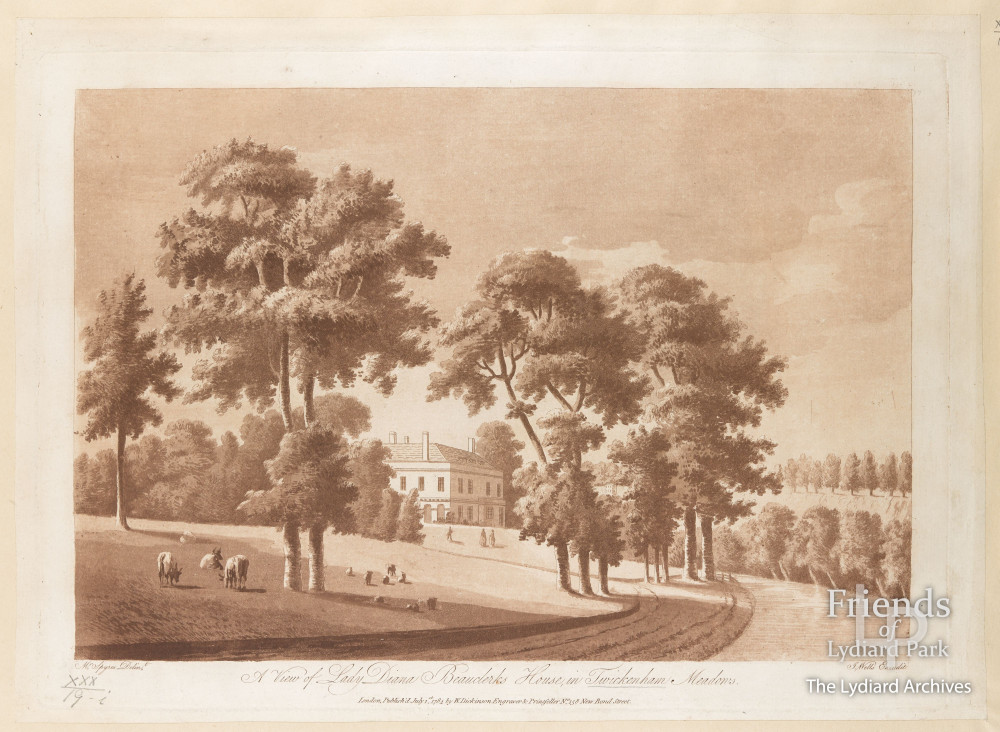Castles and Mansions Collection
The Lydiard Archives is currently featuring a special collection about the castles, mansions, gardens and country estates with a connection to the St.John family and to Lydiard Park. It gives an insight into an extended world of the family, spanning 800 years from the 12th to the 20th century and includes some iconic places, such as Corfe Castle, given to Margaret Beaufort by her son Henry VII in 1485, and the Tower of London where Sir John St.John’s sister Lucy (Apsley) was chatelaine in the run-up to the English Civil War.
In Ditchley Park, Oxfordshire, Sir John’s daughter Anne, Countess of Rochester, created a haven for Royalist espionage during a century of upheaval which is so intensely reflected in St. Mary’s Lydiard Tregoze whilst in the 18th Century the magnificent Chateau of La Source in the Loire Valley provided the exiled Henry St.John, 1st Viscount Bolingbroke with both domestic bliss with his second wife Marie-Claire de Marcilly and a place to study and share ideas with fellow philosophers Voltaire and the poet Alexander Pope.
Bolingbroke’s later and less gifted successor, George Richard St.John, 3rd Viscount Bolingbroke can even be found occupying one of America’s most treasured historic buildings, Liberty Hall in New Jersey, where his reputation somewhat tarnished the mansion’s gilded past. And finally, you can discover Brownsover Hall in Warwickshire where Lydiard’s last lord, Vernon St.John, 6th Viscount Bolingbroke retreated following his departure from the family’s ancestral home during World War II.
We are showcasing three of the properties here on the website to give an idea of the variety in time and place that is featured in the Lydiard Archives but there are many more places to discover here!
Little Marble Hill was the home of the artist Lady Diana Beauclerk from 1782 – 89 after the death of her second husband. A pretty little cottage on the River Thames at Twickenham, it was described thus: “the extreme neatness of the outside, which is perfectly white, makes it a striking and pleasing object from the river… There is a large room with a bow window to the water… It is a sweet little box.” The villa also had French windows opening onto a lawn that led down to the water, and a pretty little garden with a summerhouse. Here Lady Diana worked on many of her artistic projects including a portrait of her two daughters and a mural decoration of summer blossoms entwined on a trellis, which was a new genre. A set of large painted panels at Lydiard Park, (several on public display) are believed to have been part of her decorative schemes at Little Marble Hill.
Frederick St.John, second son of Lady Diana and Frederick, 2nd Viscount St.John married Lady Mary Kerr at his mother’s house in 1788.
Thorpe Hall near Peterborough in Cambridgeshire was the home of Oliver St.John, Lord Chief Justice (c1598-1673) and father of Lady Johanna St.John of Lydiard Park and Battersea.
The house was built for Oliver by Peter Mills between 1653 and 1656 and is unusual as it is one of very few mansions built during the Commonwealth period. At that time Parliament was disposing of church property to raise money to fund the army and navy. Oliver purchased the Manor of Longthorne where he had Thorpe Hall constructed. In 1654 the English writer John Evelyn described it as “a stately place… built on the ruins of the Bishop’s Palace and cloisters”.
The interior of Thorpe Hall is complete, except for panelling that was removed to Leeds Castle in Kent. There may have been two designers, Peter Mills and John Stone. The principal rooms have richly decorated fireplaces and plaster ceilings and the principal staircase has heavily carved foliated open panels to broad balustrade.
Liberty Hall, New Jersey, USA was built in 1772 for William Livingston, 1st Governor of the state of New Jersey and is a designated USA Landmark. During the first year of occupancy Alexander Hamilton, later the first Secretary of the Treasury lived there with the Livingston family.
Its connection with Lydiard Park came about when George Richard, 3rd Viscount Bolingbroke, purchased the fourteen-room mansion from the Livingston family in 1798. George had married his mistress in a bigamous ceremony in c1794 and the couple were living under the pseudonym of Mr and Mrs Bellasis. The gardens and orchards first planted by Governor Livingston were developed and enhanced by George and Isabella, who married again formally in 1804 after the death of George’s first wife Charlotte.
For more information, see The Lydiard Archives website.


